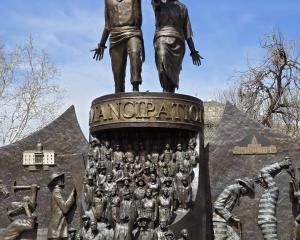Tourists looking for old Paris charm and a taste of La Vie en Rose should head to Belleville, a largely overlooked part of the city and the birthplace of Edith Piaf.
Only five Metro stops away from Paris' town hall, Belleville has retained much of its working-class identity and still bubbles with concert halls, theatres and bars - some of which Piaf once sang in.
Add to the mix successive waves of immigrants and young creative types out drinking, eating and carousing, and you get a funky atmosphere similar to New York's East Village.
It offers much for the visitor, not least a panoramic view over Paris that rivals Montmartre - but is blissfully free of peddlers and hawkers.
Yet few tourists stray farther than Pere Lachaise cemetery, burial place for celebrities including Oscar Wilde, Jim Morrison and Piaf herself. Even the success of La Vie en Rose, which won actress Marion Cotillard a best-actress Academy Award and rekindled interest in Piaf's life, isn't drawing the masses to the neighborhood.
"It's an area that hasn't yet been discovered by tourists," said Sophie Millot, a culture official from Paris' 20th arrondissement, or district, on the east side of the city where much of Belleville lies. "At the moment, it's Parisians who are starting to explore."
Since Piaf's time, Belleville has suffered from a bad reputation, cemented by the 1952 film Casque d'Or (Golden Helmet), inspired by the true story of rival bands of Belleville thugs.
Near the site of a violent fight depicted in the film, Cyril Aouizerate, a philosopher-come-nightclub owner, has built a 172-room Philippe Starck-designed hotel called Mamashelter, which opened in September. He says the district is no more dangerous than other parts of Paris.
"People who come here like the cosmopolitan feel," Aouizerate said as he puffed on a cigarette.
Be prepared, though, for scruffier streets than the sparkling avenues and boulevards of central Paris.
Once a hilltop village with a "belle vue" or beautiful view of Paris - from which the name is likely derived - Belleville was annexed to Paris in 1860 when city planner Baron Haussmann attempted to quash the locals' rebellious spirit cutting the village down the middle and splitting its administrative centre.
The man responsible for Paris' wide boulevards left the streets of Belleville largely untouched. Crooked roads that still wind their way around plots of land set out in the Middle Ages are part of the district's charm.
According to legend, Piaf was born as Edith Giovanna Gassion on the pavement outside 72 rue de Belleville in the depth of winter - attested to by a plaque outside the door.
Overwhelmed by contractions, her mother, cafe singer Annetta Giovanna Maillard, huddled in the doorway while Piaf's acrobat father went to call for an ambulance. On his way Louis Alphonse Gassion stopped in at various cafes and bars to celebrate, leaving two policemen to help deliver Edith on the sidewalk.
The reality, however, is more banal. Piaf's birth certificate states that she was born at the Hospital Tenon. It is on display at the Edith Piaf museum, two rooms of memorabilia in a Belleville apartment belonging to Bernard Marchois, the author of several Piaf biographies. He first met Piaf five years before her death when, as a young boy, he listened to her singing at her apartment in the upmarket 16th arrondissement.
The souvenirs include gold and platinum records, photos, letters and even a life-sized teddy bear, a gift from husband Theo Sarapo. Also on show is her famous little black dress, handbags, a pair of open-toed shoes and boxing gloves belonging to the love of her life, Marcel Cerdan.
Piaf's memorable voice, which Marlene Dietrich called "the soul of Paris," still haunts many of Belleville's concert halls, even if the music has changed and several have closed.
A sign outside the Nouveau Palais de Belleville, an enormous Chinese restaurant at 46 rue de Belleville, hails the Theatre National de Belleville which once stood in its place. Piaf is no longer on the menu - instead you can enjoy frogs legs with ginger.
Farther down the rue de Belleville, at No. 8, stands Aux Folies. Sip a beer on the terrace and imagine Piaf singing in the discount supermarket next door, where the cabaret Folies-Belleville used to stand.
Descending even farther, to 105 rue du Faubourg du Temple, you find a former Piaf haunt, La Java, still a concert hall which now offers pop rock and electro break drum.
Echoes of Piaf can also be found on rue Rebeval, where her maternal grandmother lived, and rue Orfila, rue des Panoyaux or rue Ramponeau, where it is claimed she lodged on her return to Paris after several years in Normandy with her paternal grandmother, who ran a brothel.
Not far from her grave in the Pere Lachaise cemetery, a statue depicting her early years as a street singer stands in the square that bears her name. Locals and fans frequent the bar Edith Piaf, behind the statue.
Like Piaf, whose mother came from Italian and Kabyle Berber (Algerian) stock, many Belleville residents point to a multiethnic heritage.
In the past two centuries, the village has welcomed newcomers who have fed its anarchistic spirit. The first came from Paris when Haussmann cleared out inner-city slums, boosting Belleville's population from 3,000 to 70,000 in the 45 years before annexation to the capital.
In the Paris Commune of 1871, when workers took control of the city for several months, the Versailles army met the toughest resistance in Belleville where, after four days of bloody street fighting, the last barricades fell.
In the 20th century, Belleville welcomed Ottoman Armenians around 1918, German Jews in 1933 and Spaniards fleeing civil war in 1939. Many Algerians and Tunisians arrived in the early 1960s, followed by Eastern Europeans and Africans in the 1980s. The most recent newcomers come from China.
A nonprofit organization called Ca se visite! offers guided tours to the district in French and English, which include opportunities to meet local residents, many of whom are artists attracted by the neighborhood's cheaper rents and chaotic charm.
"I went to the Eiffel Tower yesterday and I felt like a tourist," said Lucia Lazzeri, an Italian musician, during a recent tour. "Here, I feel like I'm tasting living history."












